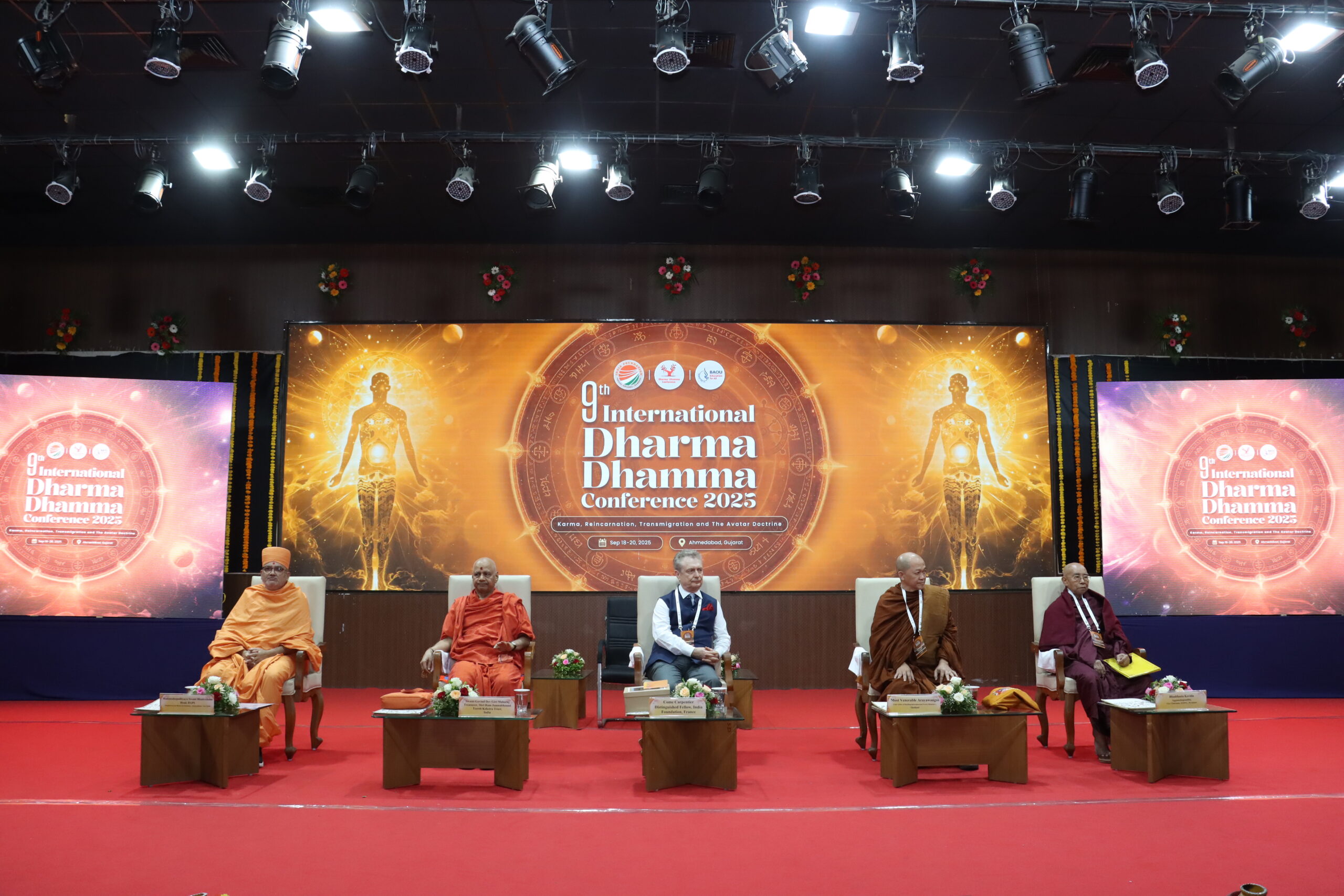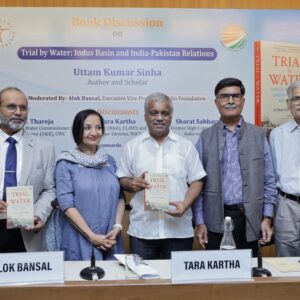India is a land of extreme diversity – in language, social order, cuisine, customs and religion. Over millennia, it mastered the art of managing that diversity and maintaining unity.
“Samaano Mantrah Samitih Samaani
Samaanam Manas Saha-Chittamesham”
– This Rig Vedic mantra laid down conditions for living together for the diverse Indian society. It meant that “May our prayers be one; our brotherhood be one; our hearts be one”. Here the sages paused. They didn’t insist that “our minds also be one”. Acknowledging “freedom of thought”, they said – “May thinking minds be together”.
Traditionally, ‘diversity of thought and unity of heart’ has been the essence of Hindu civilisational philosophy. This catholicity allowed philosophical schools like Tarka and Mimansa – dialectics, reasoning, reflection and investigation – to flourish. Tolerance and acceptance became India’s main attributes.
Across the planet, the Semites in Europe thought differently. There was only “one truth” revealed by prophets, they insisted and called upon the followers to become “believers”. Those who questioned became infidels and kafirs. Intolerance became the hallmark of the Semitic faiths.
The issue of ‘living together’ acquired complexity in India when these two world-views – one, exploratory and inclusive and the other, determinist and exclusive; one, that advocated “seeking” and the other, that insisted on “belief” – came face-to-face with each other.
Christianity and Islam, the two Semitic faiths, entered India and succeeded in converting a large number of Indians. The tolerant Indian milieu did not find it objectionable until change of faith led to change of life for the converted. A new conflict was born when the neo-Semites started rejecting hoary principles of Indian ethos like “Sarv Panth Samaadar” (equal respect to all religions), “Ekam Sat Viprah Bahudha Vadanti” (truth is one, wise men interpret it differently).
Islam’s case is more intriguing. It came to India with the Islamic invader Mohammed bin Qasim in 712 CE. The next eight centuries saw waves of Arab, Turkish and Central Asian Muslim invaders attacking India. Although invasions across the Hindu Kush were not new, Islamic invasions differed from the earlier ones like Greeks, Huns, Sakas and Kushans. They brought medieval exclusivist, intolerant and iconoclastic Islam with them.
Will Durant, the American historian called those conquests “probably the bloodiest story in history”. They resulted in acute mistrust, disunity and animosity between Hindus and Muslims.
Al-Biruni, the Iranian scholar, who came to India with the invading armies of Mahmood Ghaznavi in the early 11th century, pompously claimed that Islamic institutions were “much superior” and all the customs and usages of local communities were known for their “essential foulness”. He dismissed Hindus for “their ludicrous views” and called them “by nature niggardly…”. He also admitted that Ghazni’s iconoclasm had led to Hindus “cherish the most inveterate aversion toward all Muslims.”
Nearly three centuries later, Ibn Batuta, an explorer and traveller in the Islamic lands, observed that Hindus and Muslims lived in entirely separate communities. “It is the custom among the heathen of the Malabar country that no Muslim should enter their houses or use their vessels for eating purposes. If a Muslim is fed out of their vessels, they either break the vessels or give them away to the Muslims,” Batuta wrote.
“Allah and Mohammad could not be accommodated in the Hindu pantheon” quips eminent historiographer B.R. Nanda.
But there were phases of bonhomie too. Emperor Jehangir’s mother was a Hindu. Jehangir’s Hindu wife gave birth to his successor, Shah Jahan. Aurangzeb had a Hindu wife too. The last Mughal ruler, Bahadur Shah Zafar’s mother Lal Bai was a Hindu. Mughal royals like Akbar and Dara Shikoh demonstrated syncretism occasionally. Akbar had set up an establishment at Fatehpur Sikri for translating Indian scriptures. He got Mahabharata translated into Persian and called it Razmnama (Book of Wars). Dara Shikoh, Aurangzeb’s brother, had the Bhagavad Gita translated into Persian. He composed a study of commonalities in Hinduism and Islam and called it ‘The Mingling of Two Oceans’.
Aurangzeb, though, did not demonstrate any façade of syncretism. His rule was one of the bloodiest chapters in Hindu-Muslim relations. British Orientalist, Stanley Lane-Poole, wrote, “For the first time in their history, the Mughals beheld a rigid Muslim in their emperor – a Muslim as sternly repressible of himself as of his people around him; a king who was prepared to stake his throne for the sake of his faith. He must have been fully conscious of the dangerous path he was pursuing, and well aware against every Hindu sentiment. Yet he chose this course and adhered to this with unbending resolve.”
However, as the Mughal rule declined, rural Muslims started returning to their old Hindu practices. Poor Muslims, especially in provinces like Bengal, were as caste-ridden as their Hindu counterparts. They also used to worship Goddess Kali and participate in Durga Puja. The British Census Report of 1901 noted that the poor and uneducated Muslims used to consult astrologers, look for auspicious days to start work, and prayed to Hindu deities for all sorts of personal problems. Muslim communities in the princely states of Rajasthan like the Meos, who were converted by sword’s edge during Rajput-Mughal wars, used to even celebrate Hindu festivals like Diwali, Dussehra and Janmashtami.
In North India, a new and syncretic Islam, Sufism, also started taking roots. This tradition accommodated many Hindu practices like tolerance, saint and Dargah worship.
The last Mughal Emperor Bahadur Shah Zafar believed that Hinduism and Islam “share the same essence” and tried to restore Hindu-Muslim concord. He filled his court and army with a large number of Hindus. In his path-breaking work on the Mutiny of 1857, called “The First War of Independence”, V.D. Savarkar wrote in exuberant terms about Zafar’s enthroning in 1837. “So, in the truer sense, we said that the raising of Bahadur Shah to the throne of India was… the declaration that the long-standing war between the Hindu and the Mohammedan had ended, that tyranny had ceased, and that the people of the soil were once more free to choose their own monarch… Let, then, Hindus and Mohammedans send forth their hearty, conscientious, and most loyal homage to this elected or freely accepted Emperor of their native soil on the 11th of May 1857!”
This new-found bonhomie was in ample evidence at the First War of Independence in 1857. The war of 1857 shook the British confidence. They realised that a potential opposition to their rule was building up in the unity of various sections of the Indian society. George William Forrest, a British educator and author of “A History of the Indian Mutiny”, warned the British that the message of the 1857 revolt was that Hindus, Muslims, Brahmins and Shudras could all come together unitedly against the Raj.
Viceroy Canning got a wily idea. “As we must rule over 150 million of people by a handful of Englishmen, let us do it in the manner best calculated to leave them divided and to inspire them with the greatest possible awe of our power and with the least suspicion of our motives”, he advised his superiors in London. Thus was born the British strategy of ‘Divide et Impera’ – Divide and Rule.
Meanwhile, a new revivalist movement, known as Wahhabism, took birth in mid-18th century in Arab lands. Started by a Sunni cleric and theologian, Muhammad Ibn Abd al-Wahhab, this puritanical and exclusivist movement became a dominant stream in the Islamic world. Heft was added to it when the new ruler of Arabia, Mohammad bin Saud accorded the status of official religion to it in 1744. Petrodollars added further impetus in the 20th century. From Palestine to Pakistan, this hard-line Wahhabism is leading to the rise of radicalism and fundamentalism among Muslims today.
Wahhabism came to influence Indian Islam also. Al-Wahhab’s contemporary was a Delhi-based Islamic theologian called Shah Waliullah. He saw a big threat to Islam in the growing influence of Hindu customs and beliefs among the Muslims and decided to “purify” Indian Islam. He went to the extent of welcoming the invasion of India by the ruler of Afghanistan, Ahmed Shah Abdali.
Then came the Ahl-e-Hadith movement, started in Bhopal. This puritanical movement was also an attempt at negating the growing Hindu-Muslim proximity. These revisionist and exclusivist movements had finally succeeded in their mission when the Hindus and Muslims, who had fought together in 1857, ended up fighting against each other nine decades later in 1947.
Sir Syed Ahmed Khan, the founder of Aligarh Muslim University, was a classic example of the success of Wahhabi ideology in India.
Sir Syed started off as a strong protagonist of Hindu-Muslim unity. Addressing a large gathering in Gurdaspur in 1884, he exhorted: “O Hindus and Muslims! Do you belong to a country other than India? Don’t you live on the soil and are you not buried under it or cremated on its ghats? If you live and die on this land, then bear in mind that ‘Hindu’ and ‘Muslim’ is but religious word: all the Hindus, Muslims and Christians who live in this country are one nation”.
But in a few years’ time, the Wahhabists and the British had succeeded in transforming Syed into a rank fundamentalist. “Oh, my brother Muslims! For seven hundred years in India, you had imperial sway. You know what it is to rule. The Bengalis had never at any period held sway over an inch of the Indian soil,” Syed exhorted a few years later. “We do not want to become the subjects of the Hindus instead of the people of the Book (Christians),” he proclaimed.
Syed Ahmed was one of the earliest Muslim leaders to propagate that Muslims were a separate entity. Hector Bolitho, author of “Jinnah – Creator of Pakistan”, described Syed as the first “bold Indian Muslim” to talk about partition.
The next to champion this “Two-Nation Theory” was Mohammad Ali Jinnah. Interestingly, Jinnah too started his political career as a champion of Hindu-Muslim unity. Gopal Krishna Gokhale described Jinnah in 1910 as the “Ambassador of Hindu-Muslim unity”. Jinnah was opposed to partition of Bengal in 1906 and worked for Hindu-Muslim unity until 1916. He told his Muslim citizens that the propaganda about Hindu domination was just “a bogey, put before you by your enemies to frighten you”. But he turned into the champion of Muslim politics by 1936. In just two decades, from “Hindu-Muslim unity”, Jinnah flipped to “Hindus and Muslims cannot live together”. From a leader decrying separate electorates in 1908, he transformed into a leader championing a separate nation for Muslims three decades later.
The Two-Nation Theory of Jinnah was a fragile and lacklustre one. Intellectually it was hollow and far removed from objective reality. Jinnah’s argument that India’s Muslims had a common identity was a facile one. Muslims lived all across India. They talked different languages and followed different customs, often local and identical to Hindus. That’s why Gandhi repeatedly told Jinnah and Muslims that there couldn’t be any other homeland for them except India.
The fallacy of Two-Nation Theory was established on the day India was partitioned. Just about half of the Muslim population went over to Pakistan, while the rest remained in India, either out of compulsion – they couldn’t afford a migration, or out of choice – they didn’t support partition. In just two decades time, the much-touted Two-Nation Theory returned to haunt Pakistan when the Bengali-speaking Muslims wanted their own homeland and secured Bangladesh in 1971.
In Pakistan’s Constituent Assembly in August 1947, Jinnah tried to please his Western masters by promising to build a secular country where the minorities would enjoy equal rights as the majority. But Pakistan became a quintessential theocracy. Jinnah knew well that there was nothing else that could keep the country together except Islam. To that was added ‘hate India’. The country that Jinnah created out of the Two-Nation Theory can only survive by promoting theocracy and hating India.
Division of India was not just about lands, but hearts too. Although Hindus and Muslims continued to live together in India after partition, their hearts never met. The Hindu suspicion got fortified over decades due to Muslim intransigence on one hand and appeasement politics on the other. Kashmir to communal riots have fuelled this suspicion further.
Coming together requires that this suspicion ends. It calls for attitudinal change. Unfortunately, large sections of Indian Islam continue to be influenced by Wahhabism. Indian Muslims must reject this exclusivist and hardline version for a more inclusive, liberal and humanitarian Islam championed by institutions like Nathdlatul Ulema (NU) in Indonesia. The NU rejects the Saudi-sponsored Wahhabism. It declared that there were “no kafirs”. It called for respect to all religions and dismissed the Islamist propaganda about “Islamophobia” as a figment of imagination, if not the result of their own actions. It theologically held patriotism above Ummah.
For greater national cohesion, Muslims in India should turn to the NU’s approach. They should give up medieval concepts like blasphemy. Murders and murder threats in the name of blasphemy have seriously dented Hindu goodwill for Muslims. Many Hindus today believe that Muslims will not change.
On their part, Hindus too need to understand that perpetual hatred for Muslims cannot be the way forward. They cannot be angry at a stand-up comedian for insulting Hindu gods, and also demand the right to insult the prophet. Theologies can be contested, but narratives about gods and prophets need to be viewed from a culture-specific lens. Every religion has narratives that others may find illogical.
As Guruji Golwalkar in 1948 and Mohan Bhagwat in 2018 reiterated, Hindu Rashtra doesn’t exclude Muslims. Misplaced argument that Hindus cannot live with Muslims makes Jinnah happy in his grave while Gandhi and Golwalkar will squirm in theirs. There is a global demand that Islam should change. Hindus should demonstrate courage to help Muslims reform. They should handhold those Muslims who are fighting for that.
Continuous reform and upgradation are the unique virtue of Hindus. For Christianity, it took nearly 1,500 years, until Martin Luther came forward to challenge the orthodoxy, to reform. Islam is passing through its 15th century. Will a Muslim version of Luther surface?
It is an important question for India. Hindus are united and strong today. A serious dilemma haunts them. If the Muslim leadership fails to rise-up to the occasion, can this unity expand to encompass them? Or forced to fight back radical Islamist elements, will it end up creating a Semitic version of Hinduism – intolerant, xenophobic and aggressive?
Author Brief Bio: Shri Ram Madhav is an Indian politician, author and thinker. Besides discharging his responsibilities as a political leader, Mr Madhav is a Founding Member of the Governing Council of India Foundation (IF). In over a decade of India Foundation’s existence, Mr. Madhav has been the curator of major global and national multilateral initiatives like Indian Ocean Conference and Counterterrorism Conference involving heads of nations and leaders of governments besides academics, scholars and public-spirited individuals. A renowned author and thinker, Mr Madhav has over 200 publications to his credit. His most recent works include “The Hindutva Paradigm – Integral Humanism and the Quest for a Non-Western Worldview”; “Because India Comes First: Reflections on Nationalism, Identity and Culture” and “Uneasy Neighbours: India and China after 50 years of the war”.





The article provides a good historical account of past and contemporary scenario and should find a place in school curriculum. Vernacular press should be encouraged to republish in regional languages
Excellent narrative of history together with futuristic vision of how to go forward. It’s a nice read.
Dear Mr Madhav,
Hearty congratulations for yet another enlightening writing with out of the box thinking, for which you are well known.
Points worth deliberating upon.
Yes, hard stances do change with time, but even in materialist countries the hold of fundamentalist Islam( even though in Christian UK many old Cathedrals have been converted into pubs etc.,which I have personally observed during my visits there during my Faculty exchange visits) on the minds of Muslims is not loosening.
Indonesian NU – Nathdlatul Ulema, is also perhaps retreating, rather than gaining ascendance, something which I personally observed even during my 3-year stint in Indonesia as then Vice President of Tata Consultancy Services. In fact even Tablighi Jamaat — a strongly prosyletizing-focused organization has a major Indonesian participation.
Yes, given that among Indian Muslims, pasmandas are in numerical majority vis-a-vis ashrafs minority, there’s a hope that Indian Muslims can be perhaps weaned away from fundamentalism and exclusivist mind set. But the example of 1990 Kashmir pogrom makes it very clear that if religious stridency can bring one economic gains( eg. by way of orchards & properties of Kashmiri Hindus), the reforming and revisionist narrative among the Indian Muslims will not gain traction.
I would be grateful if in some way I can associate with India foundation on an ongoing way to take part in deliberations.
In fact on a personal note, in 2000, I had been kindly invited by then Sudarshan ji for Pragya Parvah at Shahdara, which is when I had first met you, but later lost touch due to professional engagements as VP-TCS, Sr VP-Adani, later Pro VC & VC of 3 Universities.
Basically, I have served Indian Navy for 25 years, during which I took part in 1971-war on board INS Krishna; did M.Tech from IIT Delhi. Later, post-Navy, I also delved into CSR, Human Rights and my 4th book ( about to br published) is on Human Rights and Indian CSR Laws, for which Hon. Governor Koshiyari ji and Hon. Suresh Prabhu ji have written Forewords.
I also appear on NewsX, India News, Zee etc on discussions on Strategic Affairs & Defence matters.
Thanks and regards
Cdr Dr Bhushan Dewan (retd)
WhatsApp- 9820505362
03 Sep 22
“Theologies can be contested, but narratives about gods and prophets need to be viewed from a culture-specific lens. Every religion has narratives that others may find illogical.”- This message in the article is too good. It’s correctly articulated, as the theological aspects are time-relevant.